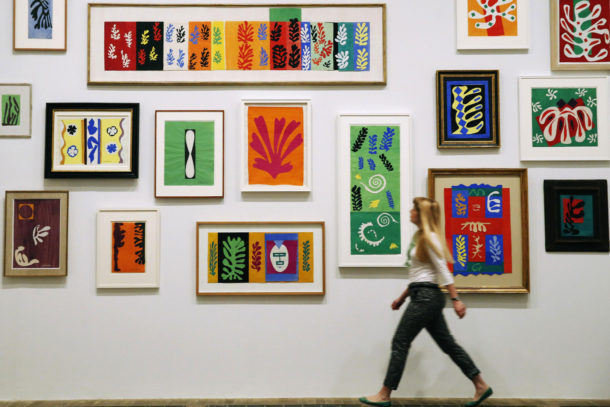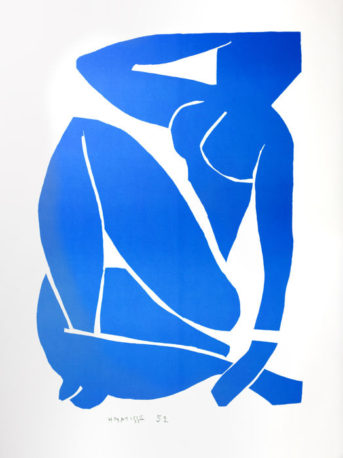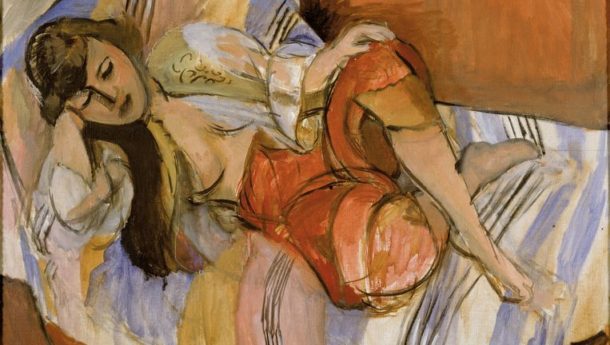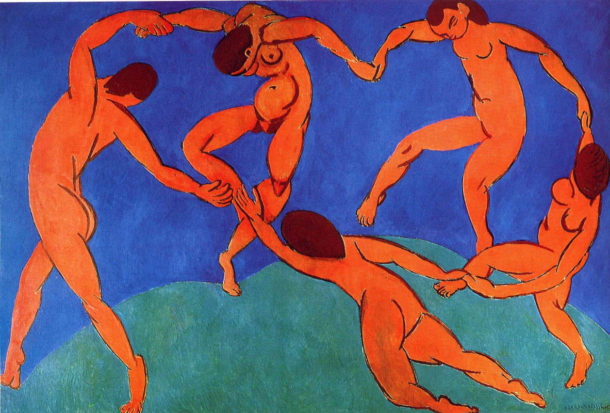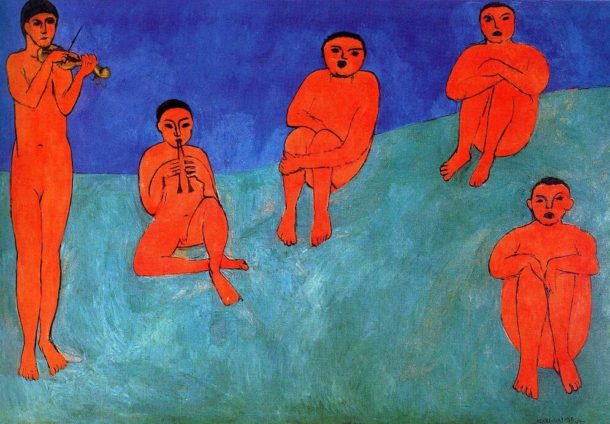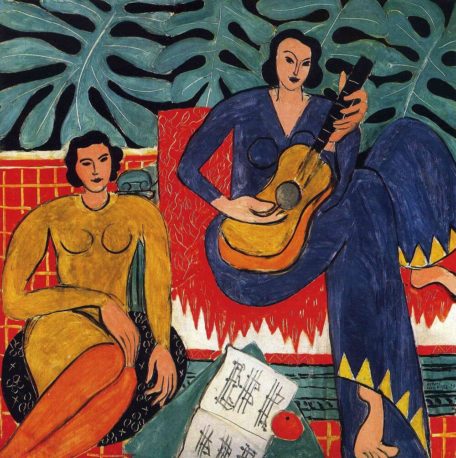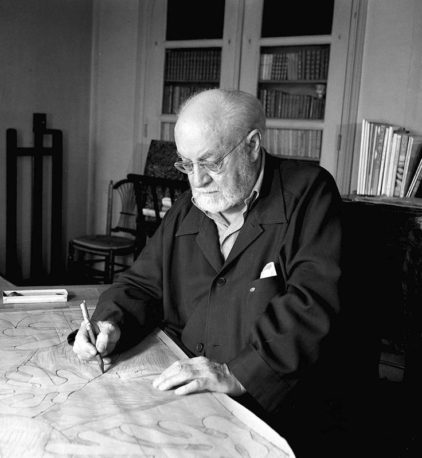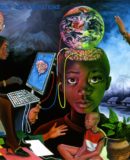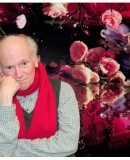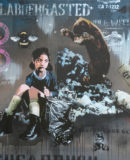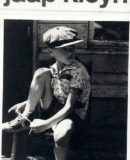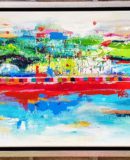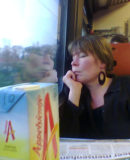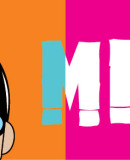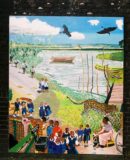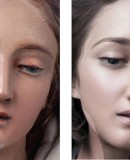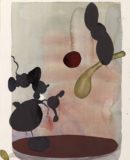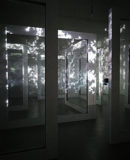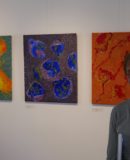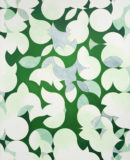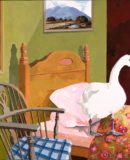World Fine Art Professionals and their Key-Pieces, 358 - Henri Matisse
World Fine Art Professionals and their Key-Pieces, 358 – Henri Matisse
‘The oasis of Matisse’ attracted a large stream of visitors in Amsterdam in 2015. 360,000 people passed the entrance gates of the Stedelijk Museum to admire not only the colorful cuttings but also his earlier paintings.
In the first decades of the 20th century, Matisse developed from a traditional painter into an avant-garde artist. In his last years Matisse became less and less a painter and more and more a draftsman and cutter. He has assistants paint sheets of paper, which he then has pinned to the wall of his studio. Hundreds of holes in the works testify to a search for the right place.
Color and shape
Henri Matisse (1869-1954) depicts nudes, fabrics, carpets, house plants and idyllic landscapes. In doing so, he searches for the most perfect possible correspondence between color and form. The exhibition showed that until his death Matisse was concerned with the minimum necessary to depict a light, cheerful carelessness: ‘the oasis of Matisse’.
Clerk
Henri Matisse is born on December 31, 1869 in Cateau-Cambrésis in northern France, the son of a grain merchant. He grows up among home weavers, who make the precious fabrics in wool and silk for the upper bourgeoisie of Paris. His mother is an amateur painter. After the Franco-Prussian War, in 1871, the family moves to Bohain-en-Vermandois, where Matisse spent his childhood. After high school, he studies law in Paris and then becomes a clerk at the notary Maître Derieux in Saint-Quentin. If he had stayed in that atmosphere we would never have known him, his name would only have been read on official records.
However, something comes up. At the age of 20 he gets an attack of appendicitis. He has to stay in bed for weeks. His mother gives him a box of paint. Thanks to the neighbour, amateur painter, Léon Bouvier, Matisse discovers the pleasure of painting. He produces his first works, ‘Chalette Suisse’, and he signs it with ‘Essitam’.
Beyond technical virtuosity
He takes drawing lessons at the Quentin de la Tour school, the local textile design school. In 1892 he returns to Paris, where he had been a student, and registers at the Académie Julian, in addition he takes an evening course at the École des Arts décoratifs. In 1892 he meets Albert Marquet at the Ecole des Arts déco. It is the beginning of a never ending friendship between the two men, who write many letters to each other. In 1895 Matisse enrolls at the École des beaux-arts, in the studio of Gustave Moreau. Moreau encourages his students to think about their painting, to dream it, beyond technical virtuosity. Matisse is encouraged to develop his own view. Gustave Moreau says when looking at a work made in class, “You’re going to simplify painting.” This remark is significant and becomes the core of Henri Matisse’s aesthetic program.
Toulouse and Ajaccio
In 1897 he discovers Impressionist painting in the Musée du Luxembourg. At that time, Matisse is a classic painter of realistic still lifes with a lot of texture. To earn a living, Matisse and Marquet work as painter decorators for theaters during the day. He has children, a girl and two boys, Marguerite, Jean and Pierre. The family moves to Toulouse and then to Ajaccio, Corsica, where, inspired by the English painter Turner, he paints 50 canvases.
Paris
From 1900 Matisse again studies sculpture at the Académie de la Grande Chaumière. He exhibites the following year at the Salon des Indépendants and in 1903 takes part in the first edition of the Salon d’Automne. Berthe Weill becomes his first dealer and in 1904 Ambroise Vollard dedicates his first personal exhibition to him. Matisse moves into a studio in the rue de Sèvres, in the former Couvent des Oiseaux.
Les fauves
At the Salon d’Automne in 1905, the works of Matisse, Albert Marquet, Vlaminck, Derain and Kees van Dongen cause a scandal with their pure and bright colours. A French critic calls these painters Fauves (wild beasts). Since 1905 this becomes the name for the representatives of French Expressionism with paintings of man and nature in bright tube colors such as red, yellow, blue, green, purple and black, in large areas, almost without perspective. The name “fauve” is immediately adopted by the painters themselves. This period marks the recognition of Matisse’s work, which finally gives him relative material comfort. He becomes the leader of Fauvism.
La Musique
He writes about his painting ‘La Musique’: “The light is not suppressed, but is expressed through an accord of intensely colored surfaces. My painting La Musique was created with a beautiful blue for the sky, the bluest of all blues. The surface was colored to saturation, that is, to the point where blue, the idea of absolute blue, appeared completely, the green of the trees and the lively vermilion of the bodies. I had my luminous resemblance to these three colors, as well as the purity of the hue.”
Stein, Picasso and Chtchoukine
Matisse meets Leo and Gertrude Stein, American collectors living in Paris, who buy from him ‘Femme au chapeau’ (woman with hat), a portrait of Madame Matisse that was on display in the ‘cage aux fauves’. In 1907 he met Picasso. Gertrude Stein defines the two artists as the ‘North Pole’ (Matisse) and the ‘South Pole’ (Picasso) of modern art.
In 1908 Matisse publishes Note d’un peintre (A painter’s notes). That same year, with financial help from Sarah and Michael Stein, among others, he opens a free academy at the Couvent des Oiseaux and then at the Hôtel de Biron (where Rodin has his presentation studio). It is an immediate success: 120 students register.
In 1909 the Russian collector Sergueï Chtchoukine orders two paintings from him: La Danse and La Musique. Considered by the painter to be two masterpieces, these two canvases are presented at the Salon d’Automne in 1910 and installed in Moscow in 1911.
La Danse is described by Marcel Sembat: “A crazy round spins pink movements on a blue background. On the left, a large figure leads the entire chain! What a drunkenness! What a bacchant! This sovereign arabesque, this gripping curve that goes from the turned head to the jutting hip, descends down the straight leg.”
Moscow, Berlin, Munich and London
Between 1908 and 1912 his works are exhibited in Moscow, Berlin, Munich and London. Matisse and his wife Amélie return to Ajaccio in December 1912. In 1913, his work can be seen at the Armory Show in New York, alongside works by Marcel Duchamp and Francis Picabia, who are the representatives of the most modern art.
From 1906 to 1913, Matisse and his painter friends Camoin and Marquet go on a winter trip to Andalusia, Morocco and Algeria. These journeys will profoundly influence Matisse – colors, ceramics, earthenware tiles – in his decorative sense of the outside world.
In 1920, Igor Stravinsky and Serge Diaghilev commissions him to design the costumes and sets for the ballet Le Chant du rossignol, which was staged in London. In 1924 Matisse exhibits in New York.
In 1925 Matisse was appointed Chevalier de la Légion d’honneur. His son Pierre Matisse opened a gallery in New York on the recommendation of his father. Matisse regularly travels to the United States. He receives the 1927 Carnegie Prize in Pittsburgh and is part of the jury that awarded the same prize to Picasso in 1930.
Bathing in the lagoon
His work focuses on still lifes, nudes and odalisques that evoke oriental nudes with shimmering colors and refined design, a kind of renewed classicism. He also publishes lithographs, engravings and drawing albums with variations on a theme, usually a female nude. In 1930 he embarks on a long journey around the world. In early February he visits New York, Chicago, Pittsburgh and crosses America to San Francisco. From there he goes to Tahiti where he met the German Expressionist director Murnau, who was filming Tabou.
“I bathed in the ‘lagoon’. I swam around the colors of the corals supported by the spiky black accents of the sea cucumbers. I dived into the water, saw the transparent absinthe bottom of the lagoon, my eyes wide open… and then suddenly I lifted my head above the water and stared at the bright array of contrasts.”
Nice and Vence
In New York, the Museum of Modern Art organizes a retrospective in 1931. On his return to Nice, in the studio in rue Désiré Niel, Matisse starts a new La Danse, of which he produces three versions between 1930 and 1933.
In 1938 he moves to Nice-Cimiez. After a difficult surgery for a cancerous tumor in 1941, the doctors give him only six months to live. From now on Matisse decides to do only what he likes, without taking into account what the others expect or demand of him. He is assisted by his nurse Monique Bourgeois, who also becomes his model.
In 1943 he goes to live in Vence. He paints flowers, lush plants, sunny interiors and sensual women. The forms in his paintings flatten and purify and simplify themselves into signs, as it were.
In 1945 a major Matisse retrospective is organized at the Salon d’Automne in Paris. The following year he shows carpet cartoons, Polynésie, le Ciel and Polynésie, la Mer.
Cut and paste
Bedridden, handicapped, but “alive”, Matisse can no longer paint or practice techniques that require diluents (water or oil). He invents the technique of cut-out papers, which he cuts in his bed with scissors, his assistants place and paste them in the desired places.
From 1949, he begins to work on the decoration of the chapel of the Rosary in Vence, at the request of his assistant nurse. The artist Jean Vincent de Crozals is the model for his drawings of Christ. The shapes are inspired by Byzantine icons.
When the painter is visited by his three grandchildren in 1950, he draws their three charcoal portraits on the ceiling of his bedroom with a 2 meter long stick. The ceiling is later removed and donated by the descendants of Pierre Matisse to the Matisse Museum in Cateau-Cambrésis.
At the age of 81, Henri Matisse represents France at the 25th Venice Biennale.
Matisse Museum
Installed in a room-studio at the Hotel Regina in Nice, he produces his latest work, La Tristesse du roi, a gouache on display at the Center Pompidou.
In 1952, the inauguration of the Matisse Museum in Cateau-Cambrésis, his birthplace, takes place. Henri Matisse died on November 3, 1954 in Nice, after drawing the portrait of Lydia Délectorskaya, one of his assistants, one last time the day before.
Famous and celebrated during his lifetime, Matisse has had a profound influence on American painting, and in particular the School of New York: Mark Rothko, Barnett Newman, Motherwell, as well as in Germany, through the students of his academy. But Pop Art painters, including Warhol and Roy Lichtenstein, also wanted to be ‘like Matisse’.
Disclaimer: The views, opinions and positions expressed within this guest article are those of the author Walter van Teeffelen alone and do not represent those of the Marbella Marbella website. The accuracy, completeness and validity of any statements made within this article are not guaranteed. We accept no liability for any errors, omissions or representations. The copyright of this content belongs to Walter van Teeffelen and any liability with regards to infringement of intellectual property rights remains with the author.


